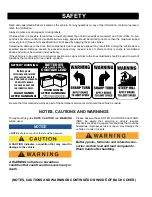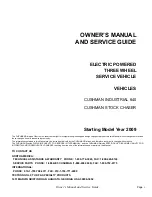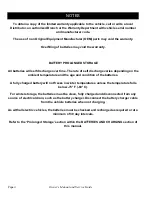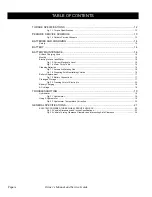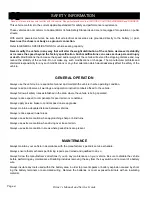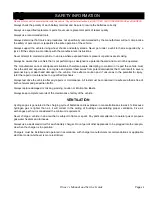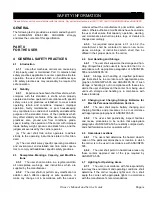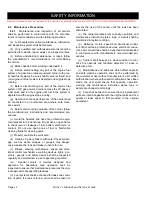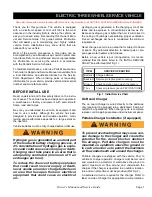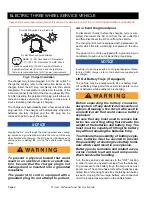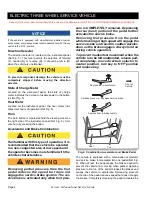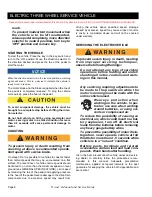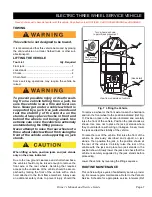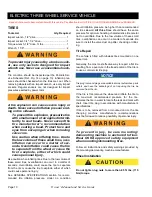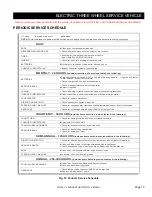
ELECTRIC THREE WHEEL SERVICE VEHICLE
Page 1
Owner’s Manual and Service Guide
Read all of manual to become familiar with this vehicle. Pay attention to all NOTICES, CAUTIONS,WARNINGS and DANGERS.
Thank you for this purchase. The vehicle is equipped
with an electronic speed control unit that is the most
advanced in the industry. Before driving the vehicle, we
ask you to spend some time reading this Owner’s Man-
ual and Service Guide. This guide contains information
that will assist you in maintaining your highly reliable
vehicle. Some illustrations may show items that are
optional for your vehicle.
Most of the service procedures in this guide can be
accomplished by an individual using common automotive
hand tools. Refer to an authorized service representative
for information on servicing the vehicle in accordance
with the Periodic Service Schedule.
To facilitate maintenance, a Service Parts Manual and a
Technician’s Repair and Service Manual is available from
a local Distributor, an authorized Branch or the Service
Parts Department. When ordering parts or requesting
information for your vehicle, provide vehicle model, serial
number and manufacture code.
BEFORE INITIAL USE
Read, understand and follow safety label on the instru-
ment panel. The vehicle has been designed to operate in
a warehouse or factory environment with semi-smooth
floors, road and ramps.
Be sure you understand the vehicle, its equipment and
how to use it safely. Although the vehicle has been
designed to provide safe and reliable operation, main-
taining good performance depends to a large extent on
the operator.
Vehicle batteries must be fully charged before initial use.
Hydrogen gas is generated as a natural part
of the lead acid battery charging process. A
4% concentration of hydrogen gas is explo-
sive and could cause severe injury or death.
Charging must take place in an area that is
adequately ventilated (minimum of 5 air
exchanges per hour).
To reduce the chance of battery explosion
that could result in severe injury or death,
never smoke around or charge batteries in
an area that has open flame or electrical
equipment that could cause an electrical
arc.
Hydrogen gas is generated in the charging cycle of bat-
teries and is explosive in concentrations as low as 4%.
Because hydrogen gas is lighter than air, it will collect in
the ceiling of buildings necessitating proper ventilation.
Five air exchanges per hour is considered the minimum
requirement.
Never charge a vehicle in an area that is subject to flame
or spark. Pay particular attention to natural gas or pro-
pane gas water heaters and furnaces.
Before a new vehicle is put into operation, it is recom-
mended that the items listed in the INITIAL SERVICE
CHART be performed (Ref Fig. 1).
On Board Charger
The on board charger is wired directly to the batteries,
only requiring it be plugged into a dedicated 15 amp AC
outlet to be operational. When charge cycle is complete,
replace cord in appropriate area under instrument panel.
Portable Charger Installation (if equipped)
To prevent overheating that may cause seri-
ous damage to the charger and create the
potential for fire, do not block or obstruct
the airways. Portable chargers must be
mounted on a platform above the ground or
in such a manner as to permit the maximum
air flow underneath and around the charger.
Portable chargers are shipped with the vehicle. Prior to
vehicle or charger operation, chargers must be removed
and mounted on a platform or wall above the ground to
permit maximum air flow around and underneath the
charger. If the charger is operated in an outdoor location,
rain and sun protection must be provided (Ref Fig. 2).
A dedicated circuit is required for the charger. Refer to
label on side of charger for appropriate circuit protection.
Fig. 1 Initial Service Chart
ITEM SERVICE
OPERATION
Batteries Charge
batteries
Backrest Remove protective plastic covering
Brakes
Check operation and adjust if necessary
Tires
Check air pressure (see SPECIFICATIONS)


